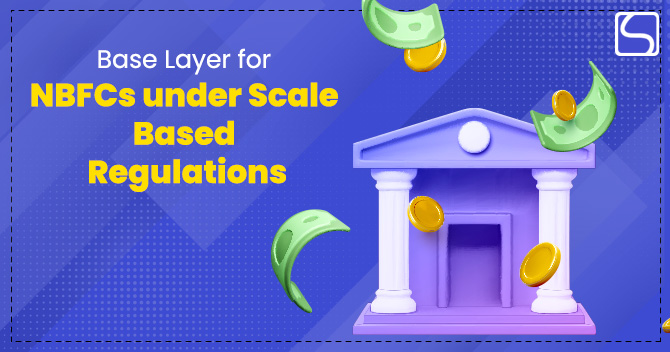Base Layer for NBFCs under Scale Based Regulations

Ganesh Nair | Updated: Aug 05, 2022 | Category: NBFC
Through the years, Non-Banking Financial Companies (NBFCs) have proved to be a vital aspect of the Indian financial landscape. NBFCs have made it easy for a large number of people to have access to credit and financial services, which the traditional banking system was unable to. NBFCs have gained a lot of popularity and continue to do so. Because of this Reserve bank of India is constantly introducing stricter regulations and frameworks. The rationale is to ensure that NBFCs don’t fail or crumble under intense market competition.
In 2021 The Reserve Bank of India (RBI)[1] released a notification on a new Scale Based Regulation for NBFCs. According to the notification, NBFCs are to be divided into four categories based on factors such as size, purpose and exposure.
Table of Contents
Categories:
- Base Layer for NBFCs– This layer will consist of Non-deposit taking NBFCs that have an asset size of less than ₹1000 crores. This layer shall also consist of (i) (NBFC-P2P), NBFC peer-to-peer lending platform, (ii) (NOFHC) Non-Operative Financial Holding, (iii) (NBFC-AA) NBFC-Account Aggregator, (iv) NBFCs that don’t avail any sort of public funds or have any customer interface.
- Middle Layer for NBFCs– This layer will include (i) all deposits accepting NBFCs irrespective of their asset size. (ii) All deposit-taking NBFCs with an asset size of more than ₹1000 crores. (ii) NBFCs that conduct- (SPDs) Standalone Primary Dealers, (IDF-NBFCs) Infrastructure Debt Fund, (CICs) Core Investment Companies, (HFCs), Housing Finance Companies and (IFCs) Infrastructure Finance Companies.
- Upper Layer for NBFCs– These layers of NBFCs shall include only those who RBI has categorically picked for enhanced regulatory requirements based on a score attained by specific methods and parameters set by the central bank.
- Top Layer for NBFCs– an NBFC shall be moved from the upper layer to the top layer by the RBI when the bank believes there is systemic risk to a certain upper layer NBFC.
This blog will explain the Base Layer for NBFCs.
Base Layer for NBFCs
The Base layer of NBFCs shall include the following:
- Non-deposit accepting NBFCs
The NBFCs that do not accept deposits and have an asset size of less than ₹1,000 crores and this shall include NBFC-ICC, NBFC MFI, NBFC-Factor and NBFC-MGC will be categorised as base Layer for NBFCs.
- NBFC- P2P
P2P stands for NBFC Peer-to-peer lending. NBFC P2P are not permitted to accept deposits or lend credit on their own instead, and an NBFC P2P shall assist in moderating the interlinking of lenders and borrowers. P2P services of the NBFCs help a lender to get the right borrower and vice versa. These interactions are carried out by the NBFC conducting due diligence via an electronic platform.
NBFC P2P also extends services like credit assessment, loan recovery, profile verification, etc. They charge a commission for all these services. Most of the loans offered under this are personal loans which are small in value and are generally unsecured. NBFC- P2P shall also be part of the base layer for NBFCs.
- Requirements for NBFC-P2P
- The entity must be registered as a company under the Companies Act 2013.
- Must have a minimum net worth of Rs.2 crore
- Must get a certificate of registration (CoR) from the Reserve Bank of India
- The entity must have the required managerial, entrepreneurial and technological capabilities to carry out P2P business.
- Services carried out by NBFC-P2P
- Can conduct due diligence on the customers
- Can perform credit assessment and risk profiling of the concerned stakeholders
- Documentation of the agreements required to complete the transaction
- Helping with disbursement and Recovery of loans that have taken place in the platform.
- Accessing and storing the data for customers, this data must be stored in hardware that is located in India.
- NBFC-AA
NBFC Account Aggregators are a framework brought forth by the RBI. The primary reason for creating account aggregators is to facilitate the transfer of data amongst the concerned stakeholders through an intermediary. The Account aggregators shall collect and store data from Financial Information Providers (FIPs) and share them with entities that require the consumer’s data, called Financial Information Users (FIUs), once the consumer consents to it. It is believed to be a massive step for interlinking the financial ecosystem. Through Account aggregators, the financial data can be shared in a safe and secure manner. This shall not only put an end to financial frauds but also reduce the transaction cost heavily. NBFC-AA will also be put under the purview of the base layer for NBFCs
- Requirements for NBFC-AA
A minimum of two crores net worth is required for NBFC-AA
NBFC-AA must have all the setup built and prepared to conduct the business 12 months after obtaining principal approval.
NBFC cannot use the customer’s data for any other purpose besides the stipulated one. They are prohibited from performing any fund-based activities.
- Services carried out by NBFC-P2P.
To keep a customer’s financial data record in a sorted manner so that it can be retrieved in an easy manner as and when required. The data must be shared with the respective entities only after obtaining the customer’s consent.
To install and maintain security measures to ensure that the data remains safe. And this data is only shared with the relevant FIU once the customer approves.
To establish a proper understanding between aggregator, financial service provider and the customer. The A must clearly define the terms of the permit; this includes things like insurance of customer, complaint redressal mechanism, risk management and data security.
- NBFC- NOFHC
RBI has permitted private/ public sector groups and NBFCS to create a bank that a Non-operative Financial Holding Company shall own. These NOFHCs shall be registered as an NBFC. The idea behind NOFHC is to allow the holding companies to venture into different commercial activities, such as joint ventures, associate ventures or subsidiaries but only after three years of its formation. NOFHCs have a distinct set of corporate governance rules. NOHFCs shall be held by only one promoter. This promoter group will overlook the group’s bank and other financial services.
- NBFCs without public funds and customer interface
NBFCs that do not hold any public funds and do not have a customer interface incorporated shall be placed on the base layer for NBFCs.
Conclusion:
RBI has divided the NBFCs into four layers, namely the base. Middle, upper and top. The scale-based regulations will help the reserve bank have better control over the NBFCs, bringing more stability to the financial sector. The regulations for the base layer are comparatively less stringent as compared to other layers. The Base layer for NBFC comprises of NBFCs with less than ₹1000 in assets, NBFC-P2P, NBF-AA and NBFC-NOFHC.
Read our Article:Scale-Based Regulations for NBFC: New Classification















